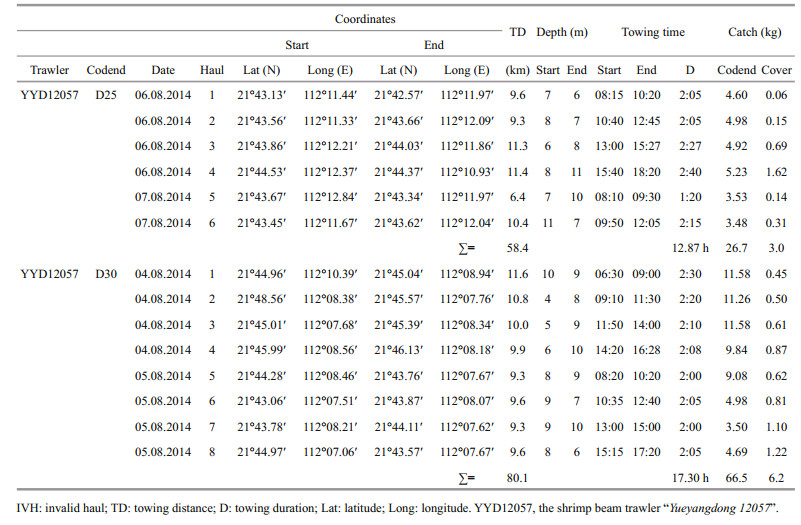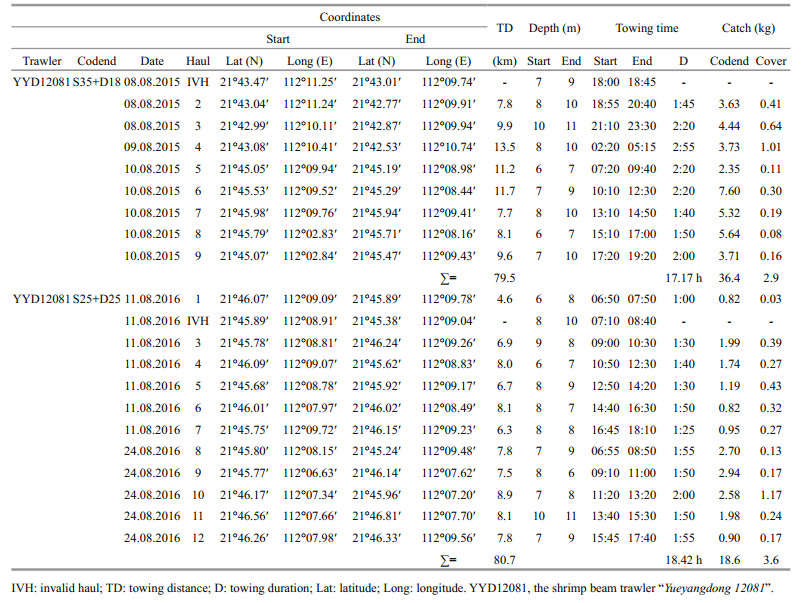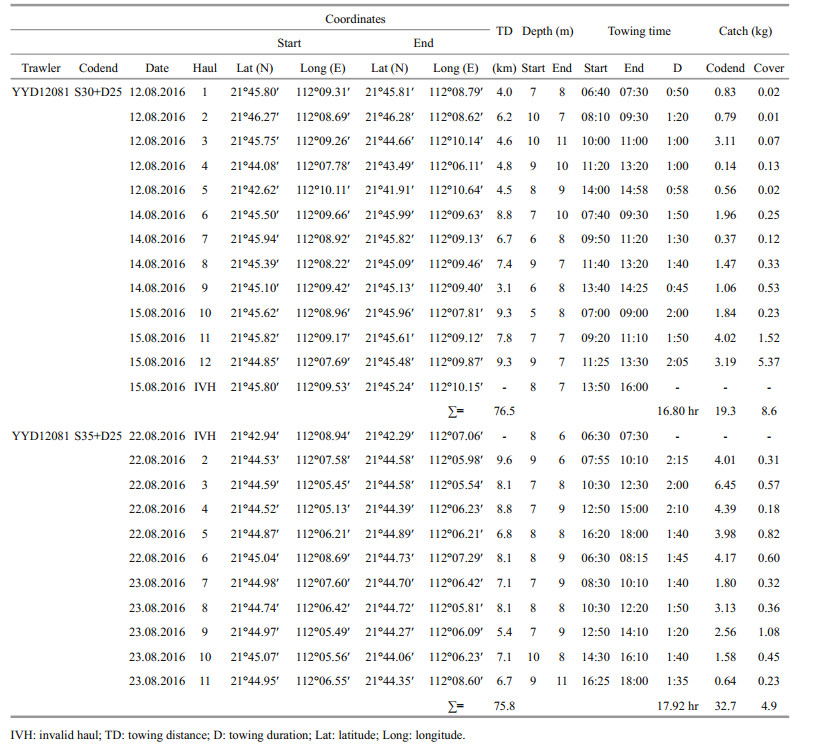Institute of Oceanology, Chinese Academy of Sciences
Article Information
- YANG Bingzhong(杨炳忠), YANG Lin(杨吝), TAN Yongguang(谭永光), YAN Lei(晏磊), ZHANG Peng(张鹏), LI Jie(李杰)
- Size selectivity of combined square and diamond mesh codends of shrimp beam trawl for banded scad Caranx (Atule) kalla in the northern South China Sea
- Chinese Journal of Oceanology and Limnology, 36(5): 1880-1890
- http://dx.doi.org/10.1007/s00343-018-7070-4
Article History
- Received Mar. 8, 2017
- accepted in principle Aug. 1, 2017
- accepted for publication Oct. 15, 2017
Shrimp beam trawl is one of the most important fishing gears in the South China Sea (Yang et al., 2002a). It has been estimated that there were 600 shrimp beam trawlers (125 092.1 kW) operating in the coastal waters of Guangdong province, and harvesting a great amount of by-catch product (Yang et al., 2015). The target species of shrimp beam trawl in the South China Sea are Greasyback shrimp (Metapenaeus ensis) and Shiba shrimp (Metapenaeus joyneri), but their production substantially vary according to the fishing seasons and fishing grounds. At some seasons, especially in the spring, they were often replaced by banded scad (Caranx (Atule) kalla) to be the main target species. The banded scad, used to be a by-catch species of bottom trawls in the South China Sea, has gradually become the commercially valuable target species of trawls and gillnets, as other traditional fish stocks have already deteriorated.
Trawling fisheries, especially shrimp trawl fisheries in tropical and subtropical areas, are notorious for their by-catch and discards problem (Hall et al., 2000; Kelleher, 2005). The situation is the same to shrimp beam trawl fishery in the South China Sea, because relatively small meshes are needed to retain the shrimp species and they usually operate in multispecies fishing grounds. Diamond mesh codends with 20 or 18 mm mesh size are often used in commercial fishing of shrimp beam trawl. The selectivity offi shing gear plays an important role in the exploitation of fish stocks and fisheries management (Mahjoub et al., 2011). It is necessary to investigate the selectivity of shrimp beam trawl to its main species, due to its poor selective properties. There are some studies on the selectivity of diamond mesh codend and square mesh codend of bottom trawl fishery in the South China Sea (Yang et al., 2002b, 2002c, 2003). According to their studies, the diamond mesh codend is good at releasing flat fish, while the square mesh codend has better selective properties for round fish. Some researcher suggests that a combined diamond and square mesh codend might be ideal for trawl fisheries in the South China Sea (Yang et al., 2003). In China, shrimp beam trawl belongs to the same legislative category of fishing gears as bottom trawl. But the fishing gears and methods of shrimp beam trawl are completely different from those of bottom trawl. Because the bottom trawl fishing vessels usually drag one trawl-net using otter boards, and the dimension of its net is much larger than that of shrimp beam trawl. While fishing vessels of shrimp beam trawl use two sticks (or beams) to operate their nets, they can simultaneity drag as much as 20 nets at one fishing operation. At present, most studies of selectivity focused on the bottom trawl, few works about the selectivity of shrimp beam trawl has been done in China (Yang et al., 2002b, 2003; Huang et al., 2016).
At present, there is no regulation about the minimum landing size (MLS) of banded scad in the South China Sea. According to Chen and Jiang (1990), the first maturity length for female banded scad is 67 mm total length, for male banded scad that length is 60 mm. In this study, the average maturity length of female and male banded scad, 63.5 mm total length, is temporarily used as its MLS in the present study.
In 2013, a minimum mesh size of 25-mm length of bar for the diamond mesh codend of the shrimp beam trawl was promulgated by the Chinese government. But this minimum mesh size has not been validated, and selectivity of diamond mesh codend of shrimp beam trawl to main target species is still unknown. A lot of work have been done to compared the selectivity of square mesh codend with that of diamond mesh codend (Broadhurst et a., 2006; Deval et al., 2009; Sala et al., 2015), most of these work proved that the selectivity of square mesh codend is better than diamond mesh codend. But in multispecies trawl fisheries, a combined netting codend of diamond mesh and square mesh was suggested, as to some species, such as flatfish, the selectivity of diamond mesh codend is better than that of square mesh codend (Yang et al., 2003; Frandsen et al., 2010, 2011). At present, there is no study about the selective properties of combined square mesh and diamond mesh codend reported in the South China Sea. The aim of our study is to test two traditional diamond mesh codends, codend with mesh size of 25-mm and codend with mesh size of 30-mm, and compare their selectivity with those of four combined square mesh and diamond mesh codends.
2 MATERIAL AND METHOD 2.1 Fishing experimentA series of fishing experiments were conducted in the northern South China Sea in August 2014, August 2015, and August 2016, respectively. The main fishing area was 21°33′–21°48′N, 112°07′–112°20′E, in which the water depth was mainly about 5–12 m, and sand and mud in the bottom. Two traditional shrimp beam trawl vessels were used in fishing experiments, named "Yueyangdong 12507" (length overall: 16 m, engine power: 79 kW) and "Yueyangdong 12081" (length overall: 21 m, engine power: 98 kW).
A commercial shrimp beam trawl-net was used in the experiments. The total stretched length of the net was nearly 7.15 m, with a net mouth of 375 meshes (with a mesh size of 28-mm). Two sticks, both with a length of 2.2 m, were equipped around the mouth of the net, the upper one was made of bamboo, and the other was made of steel. During fishing operation, two large beams (nearly 20 m in length) were stretched at both sides of the vessel, and then 12 trawl-nets were shot and equipped in order. In our experiments, all tested codends were placed at the same position and fished with others commercial nets, respectively.
Six codends with different mesh sizes and configuration were designed. The first and second codend represent the traditional diamond mesh codends, with mesh size 25 (D25) and 30 mm (D30), respectively. The other four codends were novel designs, made of combined square and diamond mesh codends, in which the square mesh codends were placed in front part connected with the anterior extension section of the net. The combined netting codends were defined as the S35+D18, S25+D25, S30+D25 and S35+D25 codend, respectively, according to their mesh sizes of the square mesh and diamond mesh (Fig. 1 and Table 1). All these codends were made from polyethene (PE) single twine, and had the same stretched length (approx. 1.5 m) and circumference (approx. 0.5 m, with a hanging ratio of 0.35 for diamond mesh codends). The experiments were conducted with the covered codend method. The cover was made of single twine PE netting with a nominal mesh size 15 mm. The specification of tested codends and cover were listed in Table 1 and Fig. 1. Under the test schedule, all designed codends were planed to have at least 10 replicated hauls test. However, as some unpredicted situation occurred, for instance, the trawl nets were blocked by great amount of jellyfish, some codends could not reach that level.
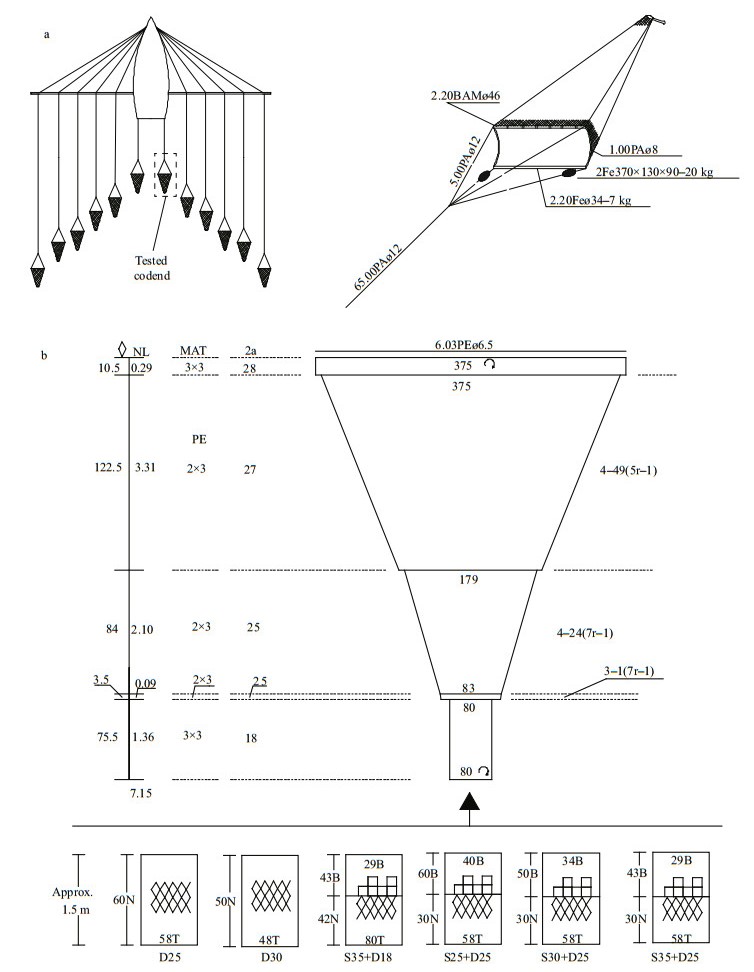
|
| Figure 1 Schematic diagram of the shrimp beam trawl (a), specification of the net and the test codends (b) |
For each haul, all catches from both codend and cover were handled separately, and classified into species levels. Each of species were weighed and counted, and the total length was measured. Due to large number of individuals, random sub-sampling was conducted at some hauls. All data were collected onboard.
2.2 Data analysisSelective curves were fitted by the logistic equation as given by Fryer (1991) and Wileman et al. (1996). In the logistic equation, the retention probability of a fish with l length entering the codend can be expressed as follow:
 (1)
(1)where r(l) is the probability that a fish of size class l would be retained, v1 and v2 are selective parameters to be estimated. By the parameters v1 and v2, the 50% retention length (L50) and selection range (SR) can be obtained as:
 (2)
(2) (3)
(3)where the parameters v1 and v2 are estimated by maximum likelihood method. The log-likelihood function is expressed as follow (Wileman et al., 1996; Tokai, 1997; Tokai and Mitsuhashi, 1998; Millar and Fryer, 1999):
 (4)
(4)where Nni is the catch number of fish with l length in the codend, Nci is the catch number of fish with l length in the cover.
To maximize the equation 4, we used SOLVER in Microsoft Excel-2003 (Tokai, 1997; Tokai and Mitsuhashi, 1998; Deval et al., 2006). Model deviance was compared to the number of degrees of freedom (dof) to judge the ability of the model to describe the fishing data (Wileman et al., 1996). If model deviance is significantly larger than dof (indicated by P < 0.05), it is necessary to determine whether the reason is the model′s inability to describe the length-based structure of the data (lack of fit), or whether it is a case of overdispersion in the fishing data (Madsen et al., 2012). Inspection of a lack of overlap between the 95% confidence limits of selective parameters, L50 and SR, was conducted to determine whether there were any differences between the tested codends (Madsen et al., 2012; Wienbeck et al., 2011, 2014; Deval et al., 2016).
As mentioned by Fryer (1991) and Millar et al. (2004), the selectivity of the same fishing gear can vary considerably from haul to haul even when deployment is replicated under controlled conditions. It is necessary to analyze data at haul level, and then estimate the mean selection curve for each codend. In the present study, the fishing data from each codend were analyzed following the procedure recommended by Wileman et al. (1996) and Deval et al. (2016). Logistic curves were fitted to fishing data at haul level with maximum likelihood method. The parameters v1 and v2, together with their variance-matrix Ri parameters, were estimated haul by haul for each codend. If the logistic equation fail to describe the experimental data, data of this haul would be discarded. Then all parameters, v1 and v2, and their variance-matrix parameters, Ri, were combined to obtain the mean selection curve by residual maximum likelihood (REML) for each codend (Fryer, 1991; Deval et al., 2016). If the REML failed to obtain available mean selective parameters, mean selection curves were obtained by pooled data of all hauls for the specific codend.
3 RESULTA total of 54 valid hauls were finished during the 3-year fishing trials: 6 hauls with the D25 codend (towing duration 12.87 h), 8 hauls with the D30 codend (towing duration 17.30 h), 8 hauls with the S35+D18 codend (towing duration 17.17 h), 11 hauls with the S25+D25 codend (towing duration 18.42 h), 11 hauls with the S30+D25 codend (towing duration 16.80 h) and 10 hauls with the S35+D25 codend (towing duration 17.92 h). Four hauls were discarded due to improper operation, in which the catch of codend and cover confused. Detailed haul information about each codend is listed in Table 2, Table 3 and Table 4, respectively.
A weight of 200.2 kg total was caught by six codends; the catch weight considerably varied, from 0.14 to 11.58 kg. A total of 30 species had been caught, including 22 fish species, 5 shrimp species and 3 cephalopod species. Among these species, 2 shrimp species, shiba shrimp (Metapenaeus affinis) and greasyback shrimp (Metapenaeus ensis), and 1 fish species, banded scad (Caranx (Atule) kalla), were dominant, which accounted for more than 85% of the total catch by weight. Only the data of banded scad was sufficient enough to further analysis of selectivity, our study focus on this species.
3.2 Selectivity analysisThe D25 codend
In total, 326 banded scad were caught; 324 and 2 individuals were in the codend and in the cover, respectively. Retention of this species was rather high (99.4%). Length distributions range between 48 and 83 mm, with a peak at 63–68 mm (79.8%) (Fig. 2a).
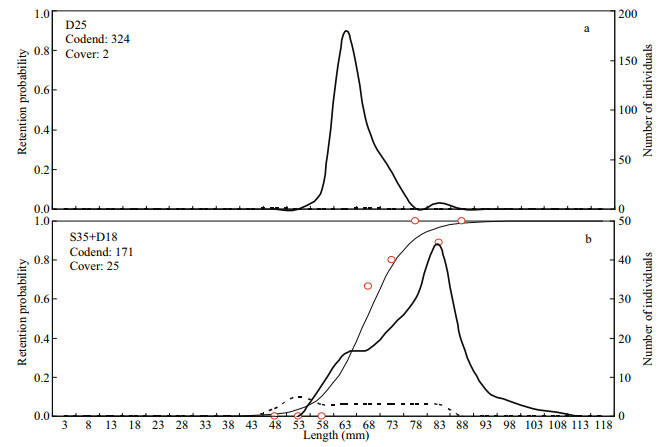
|
| Figure 2 Selection curve from individual haul (thin logistic line), observed retention values, size structure of retained (thick line) and escaped (broken line) population for the D25 (a) and S35+D18 codend (b) |
It was impossible to carry out further selectivity analysis due to few banded scad caught by the cover for this type of codend.
The D30 codend
In total, 665 banded scad were caught; 454 and 211 individuals were in the codend and in the cover, respectively. Retention of this species was 68.3%. Length distributions range between 53 and 88 mm, with a peak at 63–68 mm for the codend (74.4%), and 58–63 mm for the cover (79.1%) (Fig. 3a).

|
| Figure 3 Selection curves from individual haul (thin logistic line) and mean selection curves (red thick logistic line), observed retention values, size structure of retained (thick line) and escaped (broken line) population for the D25 (a), S35+D18 codend (b), the D30 (a), S25+D25 (b), S30+D25 (c) and S35+D25 codend (d) |
Three valid hauls provided available data for selectivity parameter estimates for the D30 codend. The fit statistics indicated that the model fitted well with the data from any haul (P > 0.05). Low numbers of individuals in cover caused high Ri values for the three hauls (Table 5). The L50 was estimated to be 59.8, 57.6 and 62.4 mm, and SR 9.1, 7.7 and 10.9 mm for the three hauls. But the model failed to converge to estimate the mean selection curve for the three individual hauls in residual maximum likelihood estimation. Pooled data analysis produced an L50 value of 59.0 mm, and an SR value of 25.4 mm.
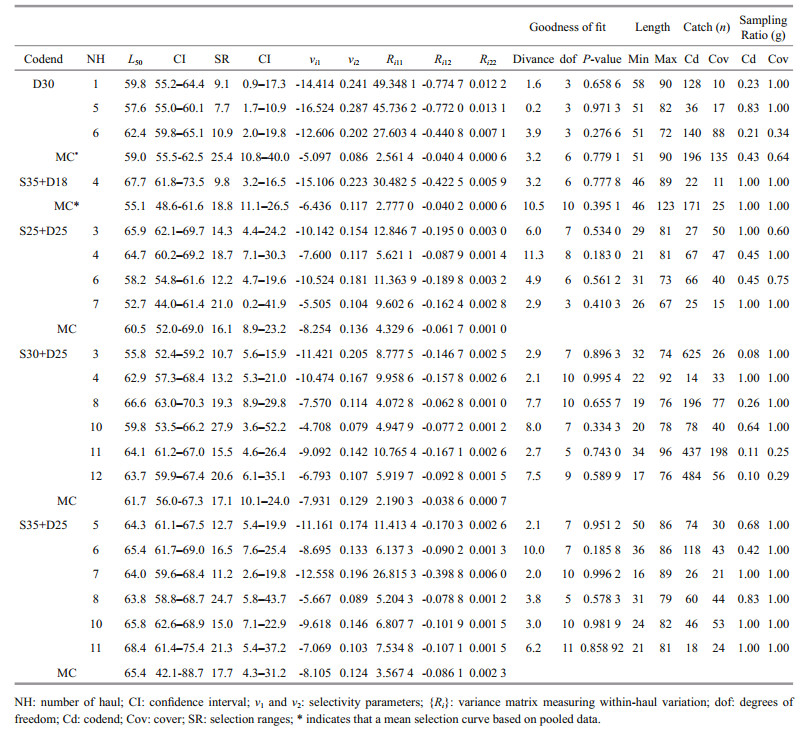
|
The S35+D18 codend
In total, 196 banded scad were caught; 171 and 25 individuals were in the codend and in the cover, respectively. Retention was 89.3%. Length distribution show their size ranges between 48 and 108 mm, with a main peak at 78–83 mm (Fig. 2b).
For this codend, catch individuals from the cover were rather few. Only one haul could provide enough specimen for further selectivity analysis. The fit statistics indicated that the logistic curve described the data well (P > 0.05). The L50 and SR were estimated to be 67.7 mm and 9.8 mm for that haul, respectively. Pooled data analysis produced an L50 value of 55.1 mm, and an SR value of 18.1 mm.
The S25+D25 codend
In total, 643 banded scad were caught; 434 and 209 individuals were in the codend and in the cover, respectively. The retention was 67.5%. Length distribution show their size ranges between 23 and 83 mm, with a peak at 63–69 mm for the codend (61.5%) and a peak at 58–63 mm for the cover (46.9%) (Fig. 3b).
Four valid hauls provided available data to obtain selectivity curves (Fig. 3b). Inspection of the fit statistics indicated that there was no problem to use logistic curve to describe the data of the four individual hauls (P > 0.05). In the mean selectivity curve, the L50 and SR were estimated to be 60.5 mm and 16.1 mm, respectively (Table 5).
The S30+D25 codend
In total, 3 223 banded scad were caught; 2 381 and 842 individuals were in the codend and in the cover, respectively. The retention was 73.9%. Length distribution show their size ranges between 13 and 98 mm, with a peak at 63–68 mm for the codend (73.5%) and a peak at 58–63 mm for the cover (54.9%) (Fig. 3c).
Six valid hauls provided available data to obtain selectivity curves. Inspection of the fit statistics indicated that there was no problem to use logistic curve to describe the data of the six individual hauls (P > 0.05). In the mean selectivity curve, the L50 and SR were estimated to be 61.7 mm and 17.1 mm, respectively.
The S35+D25 codend
In total, 697 banded scad were caught; 438 and 259 individuals were in the codend and in the cover, respectively. The retention was 62.8%. Length distribution show their size ranges between 18 and 88 mm, with a peak at 63–68 mm for the codend (73.5%) and a peak at 58–63 mm for the cover (54.9%) (Fig. 3d).
Six valid hauls provided available data to obtain selectivity curves. Inspection of the fit statistics indicated that there was no problem to use logistic curve to describe the data of the six individual hauls (P > 0.05). For some haul (7th), high Ri values were caused due to low number of banded scad caught by both the codend and cover. In the mean selectivity curve, the L50 and SR were estimated to be 65.4 mm and 17.7 mm, respectively.
Overall, the retention for immature banded sacd (defined as the fish with length < MLS=63.5 mm) was 61.41%, 61.01%, 23.98%, 55.30%, 56.03% and 24.20% for the D25, D30, S35+D18, S25+D25, S30+D25 and S35+D25 codend.
4 DISCUSSIONThe present study provides the first selectivity results of banded scad in the shrimp beam trawl fisheries in the South China Sea. The results indicate that the 25-mm diamond mesh codend is nonselective to banded scad, and this minimum mesh size for shrimp beam trawl in the South China Sea is insufficient to release immature specimens. When the mesh size enlarging to 30-mm, the selective property is much improving.
Our results indicate that the selective properties of combined square and diamond mesh codend are better than those of traditional diamond mesh codend. Theoretically and experimentally, the L50 and SR value are primarily affected by mesh size and mesh shape (Wileman et al., 1996). In our experiments, the mesh size of diamond mesh codends and that of combined mesh codends are close, from 25 mm to 35 mm. So the differences of selective properties between the diamond mesh codends and the combined square mesh and diamond mesh codends mainly result from the mesh shape. As no literature currently addresses selective properties of both diamond mesh codend and square mesh codend for banded scad, there is no information to compare with our results.
It seems that both the S35+D18 codend and the S35+D25 codend caught less immature banded scad than other four codends. But considering that the specimen of banded scad for the S35+D18 codend was less than those of the S35+D25 codend (171 vs 438, Fig. 2b and Fig. 3d), the later codend is regarded to have the best efficiency for releasing immature banded scad. In the mean selectivity curves, the L50 value of the S35+D25 is 65.4 mm, larger than those of the S25+D25 and S30+D25 codend, and also larger than the MLS of banded scad. Nevertheless, overlap of the 95% confidence intervals of the three combined mesh codends indicates that the difference of L50 might be insignificant. Larger mesh sizes for the combined mesh codend are suggested to be investigated to have a better selective property.
There are several experimental methods to test the selective properties of codend of trawl (Wileman et al., 1996). Among these methods, the covered method is the simplest one to be conducted, and easily to analyze the fishing data. But the selectivity of codend might be influenced by the existence of the covered net, which is the so-called mask-effect (Wileman et al., 1996; Madsen and Holst, 2002). In the future, other methods, such as the trouser trawl method and paired-trawl method, are suggested to compare with our study (Millar, 2010; Mahjoub et al., 2011). Besides, the difference of morphology and behaviour between target species, Greasyback shrimp and Shiba shrimp, and banded scad, should also be taken into account.
5 CONCLUSIONThe results of our study have confirmed that the selective properties of conventional diamond mesh codend (D25) are poor and is insufficient to release immature banded scad. The S35+D25 codend is suggested to be the best effective codend to release immature banded scad. For a sustainable exploitation of banded scad, larger mesh sizes are suggested to be investigated for the square mesh codends, the diamond mesh codends, and the combined mesh codends.
6 DATA AVAILABILITY STATEMENTThe datasets during and/or analyzed during the current study available from the corresponding author on reasonable request.
7 ACKNOWLEDGEMENTThe authors wish to express their gratitude to the skippers and crews of shrimp beam vessels "Yueyangdong 12507" and "Yueyangdong 12081" for their cooperation in the fishing experiments.
Broadhurst M K, Millar R B, Wooden M E L, Macbeth W G. 2006. Optimising codend configuration in a multispecies demersal trawl fishery. Fisheries Management and Ecology, 13(2): 81-92.
DOI:10.1111/fme.2006.13.issue-2 |
Chen W Q, Jiang G L. 1990. A study of age and growth and the individual fecundity of Caranx (Atule) kalla in Daya Bay. Journal of Oceanography in Taiwan Strait, 9(3): 222-230.
(in Chinese with English abstract) |
Deval M C, Bök T, Ateş C, Özbilgin H. 2006. Selectivity of PE and PA material codends for rose shrimp (Parapenaus longirostris) in Turkish twin rigged beam trawl fishery. Fish. Res., 81(1): 72-79.
DOI:10.1016/j.fishres.2006.05.007 |
Deval M C, Bök T, Ateş C, Ulutürk T, Tosunoğlu Z. 2009. Comparison of the size selectivity of diamond (PA) and square (PE) mesh codends for deepwater crustacean species in the Antalya Bay, eastern Mediterranean. J.Appl. Ichthyol., 25(4): 372-380.
DOI:10.1111/jai.2009.25.issue-4 |
Deval M C, Özgen G, Özbilgin H. 2016. Selectivity of 50 mm T0 and T90 codends for commercial shrimp species in the Turkish deepwater trawl fishery, Eastern Mediterranean. J. Appl. Ichthyol., 32(6): 1041-1057.
DOI:10.1111/jai.13128 |
Frandsen R P, Herrmann B, Madsen N, Krag L A. 2011. Development of a codend concept to improve size selectivity of Nephrops (Nephrops norvegicus) in a multispecies fishery. Fish. Res., 111(1-2): 116-126.
DOI:10.1016/j.fishres.2011.07.003 |
Frandsen R P, Madsen N, Krag L A. 2010. Selectivity and escapement behaviour of five commercial fishery species in standard square-and diamond-mesh codends. ICES J.Mar. Sci., 67(8): 1721-1731.
DOI:10.1093/icesjms/fsq050 |
Fryer R J. 1991. A model of between-haul variation in selectivity. ICES J. Mar. Sci., 48(3): 281-290.
DOI:10.1093/icesjms/48.3.281 |
Hall M A, Alverson D L, Metuzals K I. 2000. By-catch:problems and solutions. Marine Pollution Bulletin, 41(1-6): 204-219.
DOI:10.1016/S0025-326X(00)00111-9 |
Huang H L, Tang F H, Chen X Z, Zhang H, Li L Z, Song X F, Zhang S M, Wang D H. 2016. Nets selectivity of capsule size diamond mesh of Trichiurus haumela in East China Sea during Summer. Journal of Agricultural Resources and Environment, 33(5): 433-442.
(in Chinese with English abstract) |
Kelleher K. 2005. Discards in the world's marine fisheries. An update. FAO Fisheries Technical Paper No. 470. Rome, FAO: 131p.
|
Madsen N, Herrmann B, Frandsen R P, Krag L A. 2012. Comparing selectivity of a standard and turned mesh T90 codend during towing and haul-back. Aquatic Living Resources, 25(3): 231-240.
DOI:10.1051/alr/2012021 |
Madsen N, Holst R. 2002. Assessment of the cover effect in trawl codend selectivity experiments. Fish. Res., 56(3): 289-310.
DOI:10.1016/S0165-7836(01)00330-7 |
Mahjoub M S, Takeda S, Hayashi T, Shiode D, Arimoto T, Tokai T. 2011. Codend selectivity for jack mackerel and whitefin jack and unequal split parameter estimates observed in trouser trawl experiments. Fish. Sci., 77(2): 169-181.
DOI:10.1007/s12562-011-0331-1 |
Millar R B, Broadhurst M K, Macbeth W G. 2004. Modelling between-haul variability in the size selectivity of trawls. Fish. Res., 67(2): 171-181.
DOI:10.1016/j.fishres.2003.09.040 |
Millar R B, Fryer R J. 1999. Estimating the size-selection curves of towed gears, traps, and hooks. Rev. Fish Biol.Fish., 9(1): 89-116.
DOI:10.1023/A:1008838220001 |
Millar R B. 2010. Reliability of size-selectivity estimates from paired-trawl and covered-codend experiments. ICES J.Mar. Sci., 67(3): 530-536.
DOI:10.1093/icesjms/fsp266 |
Sala A, Lucchetti A, Perdichizzi A, Herrmann B, Rinelli P. 2015. Is square-mesh better selective than larger mesh? A perspective on the management for Mediterranean trawl fisheries. Fish. Res., 161: 182-190.
DOI:10.1016/j.fishres.2014.07.011 |
Tokai T, Mitsuhashi T. 1998. SELECT model for estimating selectivity curve from comparative fishing experiments. Bulletin of the Japanese Society of Fisheries Oceanography, 62(3): 235-247.
|
Tokai T. 1997. Maximum likelihood parameter estimates of a mesh selectivity logistic model through SOLVER on MSExcel. Bulletin of the Japanese Society of Fisheries Oceanography, 61(3): 288-298.
|
Wienbeck H, Herrmann B, Feekings J P, Stepputtis D, Moderhak W. 2014. A comparative analysis of legislated and modified Baltic Sea trawl codends for simultaneously improving the size selection of cod (Gadus morhua) and plaice (Pleuronectes platessa). Fish. Res., 150: 28-37.
DOI:10.1016/j.fishres.2013.10.007 |
Wienbeck H, Herrmann B, Moderhak W, Stepputtis D. 2011. Effect of netting direction and number of meshes around on size selection in the codend for Baltic cod (Gadus morhua). Fish. Res., 109(1): 80-88.
DOI:10.1016/j.fishres.2011.01.019 |
Wileman D, Ferro R S T, Fonteyne R, Millar R B. 1996.Manual of methods of measuring the selectivity of towed fishing gears. ICES Cooperative Research Report, No. 215. p.1-126.
|
Yang B Z, Yang L, Zhang P, Tan Y G, Yan L, Chen S. 2015. Fish by-catch in shrimp beam trawls in the northern South China Sea. J. Appl. Ichthyol., 31(4): 714-717.
DOI:10.1111/jai.2015.31.issue-4 |
Yang L, Lu H, Wu Z, et al. 2002a. Fishing gears and fishing methods in the South China Sea. Guangzhou, China: 237p.
(in Chinese) |
Yang L, Tan Y G, Zhang X F. 2002b. Selectivity of square and diamond mesh cod-ends of bottom trawl nets in South China Sea. Journal of Zhanjiang Ocean University, 22(3): 19-25.
(in Chinese with English abstract) |
Yang L, Zhang X F, Tan Y G, Zhang P. 2003. Selectivity study on minimum mesh size of bottom trawl codend in South China Sea. Journal of Fishery Sciences of China, 10(4): 325-332.
(in Chinese with English abstract) |
Yang L, Zhang X F, Tan Y G. 2002c. Selective experiments of square mesh cod-end of bottom trawl in South China Sea. Journal of Zhanjiang Ocean University, 22(4): 44-51.
(in Chinese with English abstract) |
 2018, Vol. 36
2018, Vol. 36




